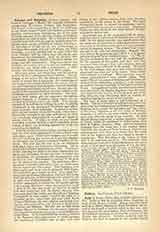

Felix I, Saint, POPE, date of birth unknown; d. 274. Early in 269 he succeeded Saint Dionysius as head of the Roman Church. About this time there arrived at Rome, directed to Pope Dionysius, the report of the Synod of Antioch which in that very year had deposed the local bishop, Paul of Samosata, for his heretical teachings concerning the doctrine of the Trinity (see Antioch). A letter, probably sent by Felix to the East in response to the synodal report, containing an exposition of the doctrine of the Trinity, was at a later date interpolated in the interest of his sect by a follower of Apollinaris. This spurious document was submitted to the Council of Ephesus in 431 (Mansi, “Coll. conc.”, IV, 1188; cf. Harnack, “Geschichte der altchristlichen Literatur-“, I, 659 sqq.; Bardenhewer, “Geschichte der altkirchlichen literatur”, II, 582 sq.). The fragment preserved in the Acts of the council lays special emphasis on the unity and identity of the Son of God and the Son of Man in Christ. The same fragment gives Pope Felix as a martyr; but this detail, which occurs again in the biography of the pope in the “Liber Pontificalis” (ed. Duchesne, I, 58), is unsupported by any authentic earlier evidence and is manifestly due to a confusion of names. According to the notice in the “Liber Pontificalis“, Felix erected a basilica on the Via Aurelia; the same source also adds that he was buried there (“Hie fecit basilicam in Via Aurelia, ubi et sepultus est”). The latter detail is evidently an error, for the fourth century Roman calendar of feasts says that Pope Felix was interred in the Catacomb of St. Callistus on the Via Appia (“III Kal. Januarii, Felicis in Callisti”, it reads in the “Depositio episcoporum”). The statement of the “Liber Pontificalis” concerning the pope’s martyrdom results obviously from a confusion with a Roman martyr of the same name buried on the Via Aurelia, and over whose grave a church was built. In the Roman “Feriale” or calendar of feasts, referred to above, the name of Felix occurs in the list of Roman bishops (Depositio episcoporum), and not in that of martyrs. The notice in the “Liber Pontificalis” ascribes to this pope a decree that Masses should be celebrated on the tombs of martyrs (“Hic constituit supra memorias martyrum missas celebrare”). The author of this entry was evidently alluding to the custom of celebrating the Holy Sacrifice privately, at the altars near or over the tombs of the martyrs in the crypts of the catacombs (missa ad corpus), while the solemn celebration of the Sacred Mysteries always took place in the basilicas built over the catacombs. This practice, still in force at the end of the fourth century (Prudentius, “Peristephanon”, XI, vv. 171 sqq.), dates apparently from the period when the great cemeterial basilicas were built in Rome, and owes its origin to the solemn commemoration services of martyrs, held at their tombs on the anniversary of their burial, as early as the third century. Felix probably issued no such decree, but the compiler of the “Liber Pontificalis” attributed it to him because he made no departure from the custom in force in his time. According to the above-mentioned detail of the “Depositio episcoporum”, Felix was interred in the catacomb of St. Callistus, December 30. In the present Roman Martyrology his name occurs May 30, the date given in the “Liber Pontificalis” as that of his death (III Kal. Jun.); it is probably an error which could easily occur through a transcriber writing Jun. for Jan.
J. P. KIRSCH

